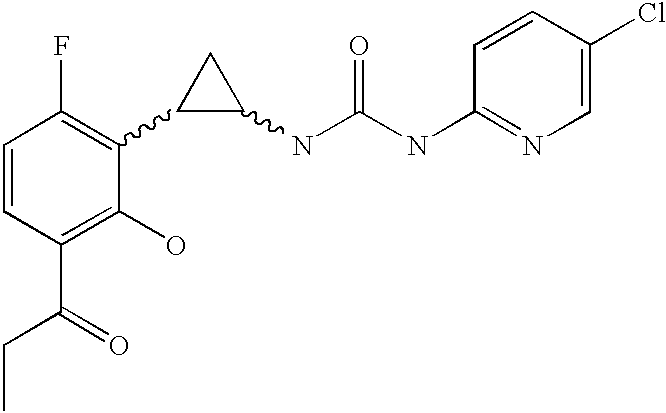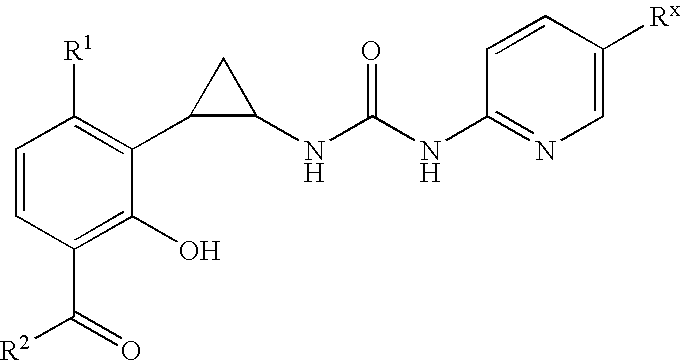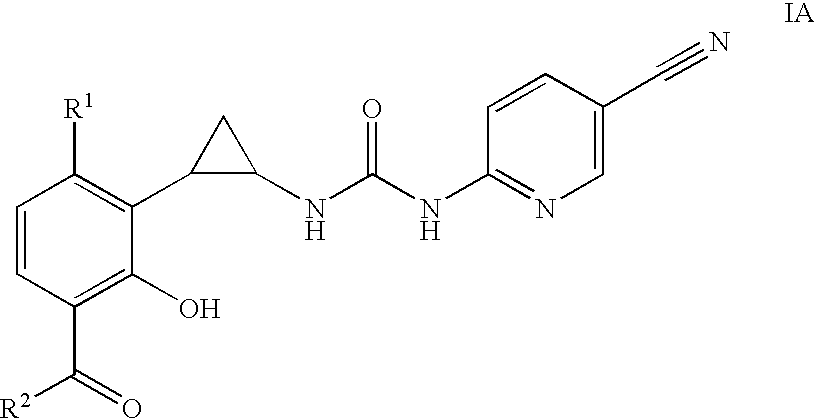Antivirals
a technology of antivirals and analogues, applied in the field of antivirals, can solve the problems of relatively high dosage levels, less specificity of nucleoside analogues, and a tendency to be toxic to nucleoside analogues
- Summary
- Abstract
- Description
- Claims
- Application Information
AI Technical Summary
Problems solved by technology
Method used
Image
Examples
example 2
3-[1,1-(Ethylenedioxy)propyl]-6-fluoro-2-methoxystyrene
To a suspension of methyltriphenylphosphonium bromide (14.3 g, 40 mmol) in THF (250 ml) at room temperature and under nitrogen was added 16 ml (40 mmol) of 2.5 M n-BuLi. To the almost obtained solution was then added 3-[1,1-(ethylenedioxy)-propyl]-6-fluoro-2-methoxybenzaldehyde (10 g, 39.5 mmol) in THF (30 ml). The reaction mixture was then stirred at room temperature for 2 h and poured into a mixture of hexanes and brine. The organic phase was washed two times with brine and one time with water. After evaporation of the solvent, the residue was filtered through a funnel filled with alumina (aluminium oxide 90 acc. Brockmann from Merck) and eluting with EtOAc 1 and hexanes 9 in order to remove the formed triphenylphosphonium oxide. Evaporation of the organic solvent gave a residue which was finally purified on silica gel eluting with EtOAc 1 and hexanes 9 to give 6.9 g (70%) of the title compound with a purity of 94.5% as determ...
example 3
(1S,2R)-cis-2-(6-fluoro-2-methoxy-3-propionylphenyl)cyclopropylcarboxylic acid
The ethyl ester of (1S,2R)-cis-2-[3-(1,1-ethylenedioxy)ethyl-6-fluoro (2-methoxy-phenyl)cyclopropylcarboxylic acid was prepared from 3-[1,1-(ethylenedioxy) propyl]-6-fluoro-2-methoxystyrene (19.4 g, 69 mmol) and ethyl diazoacetate (29 ml, 275 mmol) using a asymmetric cyclopropanation reaction catalyzed by Cu(I)triflate (679 mg, 1.35 mmol) and the chiral ligand ([2,2'-isopropylidenbis((4R)-4-tert-butyl-2-oxazoline)] (794 mg, 2.7 mmol) as generally described by Evans et al in J.Am.Chem.Soc. 1991, 113, 726-728. After silica gel chromatography, 9.4 g (40.5%) of the ethyl ester was obtained. The enantiomeric excess was 99% as determined by HPLC on a chiral column. The ester was dissolved in 150 ml of dioxane and 30 ml of 6M HCl was added. The reaction mixture was stirred over night and partitioned between ether and brine. The solvent was evaporated to give 19 g of crude produkt. This product was dissolved in me...
example 4
(1R,2S)-cis-2-(6-fluoro-2-methoxy-3-propionylphenyl)cyclopropylcarboxylic acid
This compound was prepared from 3-[1,1-ethylenedioxy)propyl]-6-fluoro-2-methoxystyrene as described for the acid in Example 3. The chiral ligand which was used was 2,2'-isopropylidenebis[(4S)-4-tert-butyl-2-oxazoline].
.sup.1 H NMR (250 Mhz, CDCl.sub.3) .delta. 7.48 (q, 1H), 6.84 (t, 1H), 3.82 (s, 3H), 2.93 (q, 2H), 2.29 (q, 1H), 2.14 (q, 1H), 1.60 (m, 2H), 1.16 (t, 3H).
Preparation of compounds of Formula I and II
PUM
| Property | Measurement | Unit |
|---|---|---|
| particle size | aaaaa | aaaaa |
| temperature | aaaaa | aaaaa |
| enantiomeric excess | aaaaa | aaaaa |
Abstract
Description
Claims
Application Information
 Login to View More
Login to View More - R&D
- Intellectual Property
- Life Sciences
- Materials
- Tech Scout
- Unparalleled Data Quality
- Higher Quality Content
- 60% Fewer Hallucinations
Browse by: Latest US Patents, China's latest patents, Technical Efficacy Thesaurus, Application Domain, Technology Topic, Popular Technical Reports.
© 2025 PatSnap. All rights reserved.Legal|Privacy policy|Modern Slavery Act Transparency Statement|Sitemap|About US| Contact US: help@patsnap.com



